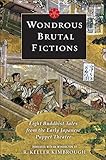Wondrous Brutal Fictions : Eight Buddhist Tales from the Early Japanese Puppet Theater.
Material type: TextPublisher: New York, NY : Columbia University Press, [2013]Copyright date: ©2013Description: 1 online resource (288 p.) : 53Content type:
TextPublisher: New York, NY : Columbia University Press, [2013]Copyright date: ©2013Description: 1 online resource (288 p.) : 53Content type: - 9780231146593
- 9780231518338
- 895.6205160803 23
- PL768.J6 W66 2013
- PL768.J6 W66 2015
- online - DeGruyter
- Issued also in print.
| Item type | Current library | Call number | URL | Status | Notes | Barcode | |
|---|---|---|---|---|---|---|---|
 eBook
eBook
|
Biblioteca "Angelicum" Pont. Univ. S.Tommaso d'Aquino Nuvola online | online - DeGruyter (Browse shelf(Opens below)) | Online access | Not for loan (Accesso limitato) | Accesso per gli utenti autorizzati / Access for authorized users | (dgr)9780231518338 |
Browsing Biblioteca "Angelicum" Pont. Univ. S.Tommaso d'Aquino shelves, Shelving location: Nuvola online Close shelf browser (Hides shelf browser)

|

|

|

|

|

|

|
||
| online - DeGruyter Privatization : Successes and Failures / | online - DeGruyter Thin Places : A Pilgrimage Home / | online - DeGruyter Four Jews on Parnassus-a Conversation : Benjamin, Adorno, Scholem, Schönberg / | online - DeGruyter Wondrous Brutal Fictions : Eight Buddhist Tales from the Early Japanese Puppet Theater. | online - DeGruyter Japan's Cold War : Media, Literature, and the Law / | online - DeGruyter Pathologies of Reason : On the Legacy of Critical Theory / | online - DeGruyter Beautiful Circuits : Modernism and the Mediated Life / |
Frontmatter -- Contents -- Acknowledgments -- Notes on the Translation -- Introduction -- Sanshō Dayū -- Karukaya -- Shintokumaru -- Oguri -- Sayohime -- Aigo-no-waka -- Amida's Riven Breast -- Goō-no-hime -- Appendix 1. Major Sekkyō Chanters -- Appendix 2. Works in This Volume -- Glossary -- Bibliography
restricted access online access with authorization star
http://purl.org/coar/access_right/c_16ec
Wondrous Brutal Fictions presents eight seminal works from the seventeenth-century Japanese sekkyo and ko-joruri puppet theaters, many translated into English for the first time. Both poignant and disturbing, they range from stories of cruelty and brutality to tales of love, charity, and outstanding filial devotion, representing the best of early Edo-period literary and performance traditions and acting as important precursors to the Bunraku and Kabuki styles of theater.As works of Buddhist fiction, these texts relate the histories and miracles of particular buddhas, bodhisattvas, and local deities. Many of their protagonists are cultural icons, recognizable through their representation in later works of Japanese drama, fiction, and film. The collection includes such sekkyo "sermon-ballad" classics as Sansho Dayu, Karukaya, and Oguri, as well as the "old joruri" plays Goo-no-hime and Amida's Riven Breast. R. Keller Kimbrough provides a critical introduction to these vibrant performance genres, emphasizing the role of seventeenth-century publishing in their spread. He also details six major sekkyo chanters and their playbooks, filling a crucial scholarly gap in early Edo-period theater. More than fifty reproductions of mostly seventeenth-century woodblock illustrations offer rich, visual foundations for the critical introduction and translated tales. Ideal for students and scholars of medieval and early modern Japanese literature, theater, and Buddhism, this collection provides an unprecedented encounter with popular Buddhist drama and its far-reaching impact on literature and culture.
Issued also in print.
Mode of access: Internet via World Wide Web.
In English.
Description based on online resource; title from PDF title page (publisher's Web site, viewed 02. Mrz 2022)


